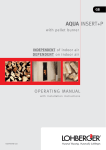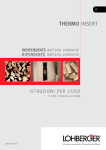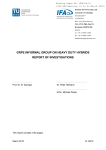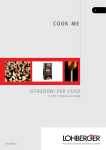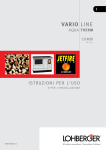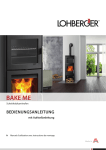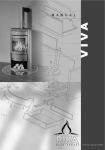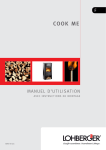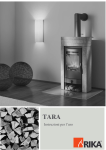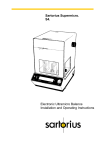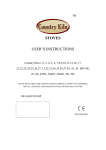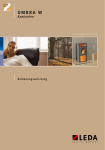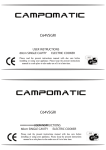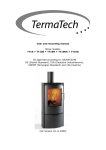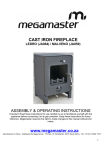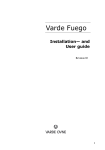Download COOK ME - Lohberger Heiz
Transcript
GB COOK ME USER MANUAL WITH INSTALL ATION INSTRUCTIONS Edition May 2011 DRAWING EXPLANATION Important information in this manual is indicated by the following symbols: Important information Practical advice Use the plan Contents 1. IMPORTANT INFORMATION............................................3 1.1. GENERAL WARNING AND SAFETY INSTRUCTIONS 1.2. BEFORE SETTING UP 1.2.1. Ground load bearing capacity: 1.2.2. flue pipe connection 1.4. AIR FOR COMBUSTION 7. OPERATION....................................................................8 3 3 3 4 4 7.1. STARTING THE FIRE 8 7.2. ASH DRAWER 9 7.3. OPERATING THE SHAKER GRATE 9 7.4. SLIDE SETTING AT RATED THERMAL OUTPUT9 2. PACKAGING....................................................................5 8. FITTING OPTIONS..........................................................9 3. TECHNICAL SPECIFICATION............................................5 4. LIST OF COMPONENTS...................................................6 5. BRIEF HEATING INFORMATION.......................................7 5.1. SUITABLE FUELS AND FUEL QUANTITIES 5.2. FUEL QUANTITIES 5.3. MAXIMUM FUEL QUANTITIES 5.4. CLEAN BURNING 5.5. BURNING WOOD 5.6. Heating in the transitional period 7 7 7 7 7 7 6. INSTALLING THE FIRE....................................................8 6.1. CONNECTING THE FIRE 8 8.1. MAKING AN EXTERNAL COMBUSTION AIR FEED 9 9. MAINTENANCE AND CLEANING......................................10 9.1. GENERAL MAINTENANCE 9.2. ONCE MORE 9.3. FINISH - CONDITION AND CLEANING 9.4. CONVECTION AIR OPENINGS 9.5. CLEANING THE FLUE GAS CHANNELS 10 10 10 10 10 10. PROBLEM SOLVING......................................................11 11. Request for customer service ......................................12 12. NAMEPLATE ................................................................13 13. THE LOHBERGER WARRANTY........................................14 14. CONNECTING DIMENSIONS..........................................15 General information The slow-burning stoves of series COOK ME are built according to the current state of the art and comply with the requirements of the following standards for wood as fuel: • The European standard EN 12815, ÖNORM M 7550, the German industrial standards DIN 18882, DIN Plus, and BIMSCH. • Agreement of the Provinces between Federation and Provinces according to Art. 15a B-VG (Federal Constitution Act) on protective measures concerning minor furnaces and the saving of energy dated June 1995. • Special provisions in terms of efficiency and pollutant emission applicable in Regensburg and Stuttgart. All safety valves used for the installation must be certified (reference letter „H“ in the component certification register!), their flow rate must correspond to the highest nominal output of the boiler. Further points to be observed: - Heating room guidelines, - National building regulations, - Local building regulations, - Commercial and fire police regulations, - Environmental protection regulations, Page 2 FOREWORD Dear Customer, First of all we would like to thank you for your custom and congratulate you on your excellent choice. To make sure that your new heating stove COOK ME lives up to your expectations, please observe the instructions in this operating and maintenance manual carefully. The LOHBERGER heating appliances (in the following referred to as “heating stove”) are manufactured and tested in accordance with the applicable safety regulations of the relevant European guidelines. This manual is intended for use by the owner of the heating stove as well as by the HVAC installer, operator or maintenance staff. If you have any queries or you require further information as regards the manual, please do not hesitate to contact the manufacturer or an authorized customer service centre. Make sure that you indicate the paragraph number and the subject of your query. The print, translation and reproduction of this manual, whether in full or in part, are not permitted without the consent of LOHBERGER. The technical information, graphic illustrations and specifications must not be distributed in any way. Your LOHBERGER Heiz + Kochgeräte Technologie GmbH 1. IMPORTANT INFORMATION In the event that some of the instructions contained in this manual are not clear, please contact the LOHBERGER expert staff. LOHBERGER reserves the right to make changes to the specifications as well as to the technical and functional features of the appliance at any time and without further notice. 1.1. GENERAL WARNING AND SAFETY INSTRUCTIONS The general introductory warning information must be followed. -> Read the whole of the manual thoroughly before commissioning the fire. -> Only approved transport aids with adequate load bearing capacity must be used for transporting your fire. -> Do not change the stove, except using original accessory components supplied and tested by us or work performed by our works service. ->Your fire is not suitable for use as a ladder or scaffold -> Thermal energy is produced by burning fuel; this leads to the surface of the fire, the doors, the door and operating handles, the door glasses, the flue pipes and possibly the front wall of the fire becoming very hot. Avoid touching these parts without wearing the relevant protective clothing or using the relevant means (cold hand). -> Make children aware of the danger and keep them away from the fire when in use. -> Only burn the approved fuel listed in the chapter “Clean Burning”. -> Burning or inserting easily combustible or explosive materials, such as empty spray cans and suchlike in the fire, as well as storage of the same close to the fire is prohibited due to risk of explosion. -> When reheating , no wide or easily combustible clothing should be worn. -> Setting down of non heat resistant objects on the fire or nearby is prohibited. -> Do not lay washing on the fire to dry. -> Stands for drying items of clothing or suchlike must be set up at an adequate distance from the fire – fire hazard!. -> Working with easily combustible and explosive materials in the same or adjoining room to the fire is prohibited when the fire is on. 1.2. BEFORE SETTING UP 1.2.1. Ground load bearing capacity: Before setting up, ensure that the supporting construction has a load bearing capacity that will support the weight of the fire. Commissioning details are shown on the sticker on the Ceran area. Page 3 SAFETY CLEARANCES (Minimum clearances) 1.3.2. Use the devices supplied with your fire, such as the protective gloves or the cold hand to open the doors, as well as for operating the control elements. 1. From non-combustible items a > 400 mm b > 100 mm 1.3.3. 2. From combustible items and supporting walls made from reinforced concrete construction a > 800 mm b > 200 mm. Design 1 fires (BA 1): These fires must only be operated with the fire door closed. 1.3.4. The fire door must only be opened for adding fuel and must then be closed again, as this could otherwise lead to a danger to other fires that are also connected to the chimney. b b 1.3.5. When the fire is not in operation, the fire door must be kept closed. 1.3.6. a b When using wet fuel and if operation is throttled too much, the chimney can soot up, i.e. easily combustible materials such as soot and tar can be deposited and this can lead to a chimney fire. Should this happen, close all air inlet slides and flaps. Call the fire brigade and get yourself and all other occupants to safety. ATTENTION: The size of the fire door means that, particularly when reheating blazing flames, the door must not be opened abruptly, in order to prevent the flames from springing out. 1.2.2. flue pipe connection Flue pipes are a particular hazard source in respect of escape of poisonous gas and fire hazard. Obtain the advice of an appointed specialist company in respect of laying and fitting the pipes. When connecting the flue pipe to the chimney, in the area of walls cladded using wood, please follow the relevant fitting directives. 1.2.3. You must follow the flue gas formation in the event of unfavourable weather (atmospheric inversion) and the draught conditions. If too little combustion air is added smoke can enter your house or flue gases can escape. Additionally harmful deposits can arise in the fire and in the chimney. In the event that flue gas escapes let the fire go out and check if all air inlet openings are free and the flue gas feeds and the fire pipe are clean. In cases of doubt you must inform the master chimney sweep, as a fault in the draught could be due to the chimney. 1.3. 1.3.7. The primary and/or secondary air supply must be open before you open the combustion chamber door. 1.4. AIR FOR COMBUSTION Basically, the appliance is dependent on indoor air, that means the air supply needed for combustion is extracted from the room where the appliance is positioned - periodic ventilation, especially with very hermetically sealed building systems, is mandatory. If there are additional heating units in the same room, the ventilation openings must provide adequate air supply for combustion to ensure proper operation of all appliances! Too low pressures in the room where the appliance is located (e.g. caused by ventilation systems, extractor hoods etc.) or in the pellets container (e.g. caused by pneumatic appliances) are likely to impair the functioning of the fire place and their safety (technique) and are therefore not permitted. Before adding new fuel, push the embers together. 1.3.1. Only use a suitable tool from our accessory range for pushing the embers together, and ensure that no combustible material falls out of the fire. Page 4 The operation of open heat systems depend on indoor air in combination with ventilation, etc. is only under special conditions allowed. Check with the manufacturer of your ventilation system. 2. PACKAGING Your first impression is important to us! - The packaging for your new fire provides excellent protection from damage. However damage to the fire and accessories can occur during transport. Therefore please check your fire for damage and that all parts are there on receipt! Report any defects to your fire dealer immediately! When unpacking please ensure that the soap stone panels are intact. The material scratches easily. Soap stones are not covered by the warranty -The packaging for your new fire in the main has no effect on the environment. The wood in the packaging has not been surface treated and can therefore be burned in your fire. The box and the film (PE) can be recycled without any problem. CONNECTING DIMENSIONS 3. TECHNICAL SPECIFICATION „CONNECTING DIMENSIONS“ on page 15 This is a Design 1 fire and has a connection for fitting to a chimney that is equipped for other fires and boilers for solid and liquid fuels, insofar as the chimney dimensions are in accordance with DIN 4705, Part 3 Technical Specification Dimensions (mm) and weights (kg) Height 958 Width 516 Depth of the corpus 441 Weight without casing 97 Weight with ceramic panel 115 Flue pipe outlet diameter 130 Rated heating capacity as per EN13240 7 kW Lowest thermal output 3,5 kW Room heating capacity (m3) dependent on the house insulation 70 - 190 Fuel flow 1,2 kg/h Efficiency 83,4 % CO2 content 9,9 % CO emission rel. 13% O Dust emissions 701 mg/Nm3 m 44 mg/Nm3 Flue gas values for multiple connection to a chimney as per DIN 4705,Part 3 or for measuring the chimney as per DIN 4705, Part 2 Flue gas mass flow g/s Abgastemperatur/°C Minimum flow pressure at rated heating capacity 5,7 226,6 12 The owner of the small heating system or the authorised person for the small heating system must keep the technical documentation in a safe place and present it to the local authority or the chimney sweep. Page 5 4. LIST OF COMPONENTS Description 1) Pendant bottom 21) Round sealing strip D12 2) Exhaust gas pipe connection 22) Ash drawer 3) Hinge nut 23) Secondary air lever 4) Handle sleeve 24) Log guard 5) Clamp bolt 25) Flue plate rear 6) Door latch 26) Panel front top (not painted) 7) Riddling washer 27) Panel holder top right 8) Furnace belt 28) Panel holder top left 9) Glass connections 29) Cast iron cover 10) Door stop 30) Ceran cooking surface 11) Primary air slider 31) Rear wall 12) Riddling grate lever 32) Decorative steel sheet lateral (not painted) 13) Riddling grate actuator 33) Door handle complete 14) Side wall panelling aluminium profile 34) Round sealing strip DM7/L=1220 15) Firebox door complete 35) Round sealing strip DM7/L=1230 16) Firebox door painted 36) Oval-head screw with Allen screw 17) Firebox door glass 37) Handle disk spring 18) Firebox lining (fireclay) 38) Slotted headless screw with chamfered end 19) Firebox lining front right (fireclay) 39) Threaded bar with Allen screw and full dog point 20) CULIMETA_8x2 40) Riddling grate Page 6 5. BRIEF HEATING INFORMATION 5.1. SUITABLE FUELS AND FUEL QUANTITIES The following is important for clean burning: In principle your fire is suitable for burning dry billets. You can also burn fuels such as wood brickets. 1. THE FIREWOOD MUST BE DRY AND UNTREATED. Only use dry fuel. The burning of waste of any kind, in particular plastics, damages your fire and the chimney, and is prohibited by the Emissions Protection Ruling. Dry and well ventilated stored wood that has been stored for 2-3 years. 5.2. FUEL QUANTITIES The fire is equipped with flat firing due to the design. This means that only one layer of fuel may be placed on the existing basic embers. Please note that when a larger quantity of fuel is added, your fire will emit a larger quantity of heat or will heat up more strongly than is intended for the design. This can lead to damage to your fire. Recommended value < 15% rel. wood humidity. A fire is not a „waste incineration plant“. The warranty will become null and void if rubbish or non-approved material, such as plastic, treated wood etc. is burned. Further consequences are damage or soiling of the fire and chimney as well as the environment 2. CORRECT FIREWOOD QUANTITY AND FIREWOOD SIZE -> Too much firewood causes overheating. This causes the material to burn too heavily and your fire will produce poor flue gas values. 5.3. MAXIMUM FUEL QUANTITIES Wood: -> Too little firewood or too large billets have the effect that the fire does not reach the optimum temperature. The flue gas values are poor here. 2 billets à approx. 0,9 kg -> The correct firewood quantity means: Wood brickets (broken): for wood _ 1.8 kg (2 billet - 25 cm long) per layer (recommended value) at rated thermal output 6 kW. 2 off à approx. 0,9 kg At the smallest thermal output (3 kW) = 0.9 kg (2 billets - 25 cm long) Your fire output is regulated via the air inlet slide. As your fire output is also dependent on the chimney draught, you must get used to the use of this slide according to your own experience. The secondary air regulator, the primary air regulator and the shaker grate handle may only be used with the shaker hook enclosed. Note: Only wood and wood brickets must be burned in your fire. Plastic, treated wood materials (e.g. chipboard), hard coal or textiles must not be burned. 5.5. BURNING WOOD Clean burning of wood corresponds to the same chemical process as natural decay, i.e. that the CO2 (carbon dioxide) released does not increase or contaminate the original CO2 content – household of the atmosphere. 5.4. CLEAN BURNING The challenges of the present day and age mean that everyone must act responsibly. One of most important matters of concern is retaining our natural world. Our products are developments that comply with the most recent state of the art technology. This is an essential prerequisite for a clean, efficient and perfect functioning of our fires 5.6. Heating in the transitional period At temperatures above 15 °C there is a risk based on a low delivery pressure witch causes only a moderate fire. This results in an increased formation of soot in the chimney flue of the stove and in the chimney. Increase the supply of primary air, stir up more often and put frequent smaller pieces of wood on to prevent formation of soot in transition time. Page 7 6. INSTALLING THE FIRE Before first commissioning or after changing the location of the fire, cleaning and service work, ensure that the flue plate, as well as the wood stop (LIST OF COMPONENTS; page 6; Part 24 and 25) is in the correct position. When usinga flue pipe with throttle valve, the throttle valve must be open. Care must be taken with this fire that the flue draught reaches at least the prescribed value (> 0.8 mbar). Should problems arise here, please contact your master chimney sweep Caution! Remove the sticker from the Ceran area before using your fire for the first time. Important: The Ceran area becomes very hot during use and only cools down very slowly. There is an acute danger of burning up to one hour after fire has gone out! 6.1. CONNECTING THE FIRE Proceed as follows when fitting a connection to a bricked chimney: 1. Measure and draw in the chimney connection (taking a possible floor plate thickness into account) as per the natural dimension First seal the wall lining using mineral wool insulation. Afterwards plaster using heat resistant cement mortar or equivalent. 4. After the mortar has hardened, and after plastering and painting , position the floor plate including the floor protection (carton). 5. The fire can now be lifted onto the floor plate carefully. The fire must not be pushed along an unprotected floor. Strong corrugated cardboard, carton, or an old carpet are excellently suited as an installation aid and an underlay. The fire can also be pushed on this underlay. We recommend original flue pipes from the LOHBERGER flue pipe range for professional connection. The connecting piece must not project into the chimney shaft! Seal the gap between the flue pipe and wall lining using a ceramic seal. The installation must comply with the respective safety and construction regulations. Please contact your master chimney sweep in this respect – he will be happy to give you information If you use a system chimney (e.g. glazed fireclay), we would ask you to follow the manufacturer’s connection regulations exactly. 2. Chisel out (drill) the holes in the wall 3. Brick in wall lining 7. OPERATION 7.1. STARTING THE FIRE (Safety clearances; page 4) In order to keep exhaust emissions as low as possible, we would ask you to keep to the following starting instructions. 1. If the fire and chimney are still cold or if there is atmospheric low pressure, then burning some paper at the start is recommended, in order to “drive” the cold out of the fire and chimney. 2. To start heating first lay untreated paper on the floor of the combustion chamber, on top of that 0.5 kg soft wood chip and 1 kg wood (3 small billets). Pull the shaker grate handle (Part II) out completely and open the primary (Part I) and secondary air slide (Part III) Please do not use glossy paper or paper from magazines. It does not burn well and the print colours produce very poisonous substances in the flue gas. Page 8 3. Now light the paper. Wait until the soft wood chips are burning well. Close the shaker grate handle and the primary air slide a few minutes later. Set the secondary air slide to the ideal setting a few minutes later. 4. After this has burned, lay approx 1.6 kg wood (3 billets) on the fire. Open the shaker grate handle and the primary air slide until the wood is burning well (approx. 2 mins). The secondary sir slide remains in the ideal setting. Proceed in the same manner for each further layer. 5. The mineral parts of the wood (approx. 1%) remain on the bottom of the combustion chamber as combustion residue. This ash is – because it is a natural product - an excellent fertiliser for all plants in the garden. However the ash should be left to settle beforehand and doused with water. THE FIRE PAINT ONLY HARDENS PROPERLY AFTER HEATING UP DURING USE. 7.3. OPERATING THE SHAKER GRATE - Do not touch the surface during heating. It is still soft. The ash is moved from the fire into the ash drawer (part 22) by moving the Riddling grate actuator (Part 13). This frees up room for the primary feed air that is required for the heating phase in the fire. - Our paints are completely harmless in accordance with the TÜV-certificate; there is no danger to health. In spite of that we recommend that the house is well ventilated several times after first heating. It is not necessary to operate the shaker grate during heating. -Heat the fire up well – this will reduce the hardening time. - Hardening of the surface is complete after several proper periods of heating. All details on the nature of the fire wood and correct heating can be found in Chapter 5. 7.2. ASH DRAWER The ash drawer must be emptied regularly to prevent excessive heating of the fire grid OPERATING THE SHAKER GRATE 7.4. SLIDE SETTING AT RATED THERMAL OUTPUT Fuel Wood/Wood Brickets Primary air closed Secondary air 1/3 open Shaker grate closed The position „Primary air completely open“ may only be used as a starting position. As your fire output is also dependent on the chimney draught and the weather conditions, you must get used to the use of this secondary control slide according to your own experience. Never heat the fire with the ash drawer open > danger of overheating >loss of warranty. Caution: Embers could remain in the ash. Only fill the ash into non-flammable containers and do not put the ash onto flammable surfaces. 8. FITTING OPTIONS 8.1. MAKING AN EXTERNAL COMBUSTION AIR FEED -> Dismantle the rear wall following the instructions: Take off the Ceran cooking surface (pos. 30). Then loosen the four screws of the cast iron cover (pos. 29) and lift it. Now pull the rear wall from the aluminium profiles upwards (pos. 14). -> Cut out the pre-cut, round section from the rear wall (pos. 31) (hack saw blade). Tighten the supply air inlet pipe (optional, on order) by means of the supplied screws and remount the rear wall. -> Connect a non-flammable pipe (e.g. steel spiral pipe) to the supply air inlet pipe and fasten it with a hose-clamp (not included in the delivery!). -> To ensure sufficient supply of air, the pipe should not exceed a length of 4 m and have no bends. -> If the pipe runs to the outside, the pipe end must have a vertical 90°bend downwards or be protected against wind. Page 9 9. MAINTENANCE AND CLEANING 9.1. GENERAL MAINTENANCE Your Cook ME has been designed by our development team with minimal maintenance in mind and for a very long service life. Certain cleaning activities and checkin the seals are however necessary from time to time. The time periods between the inspection intervals are above all dependent on the fire wood quantity used and the frequency of use. All maintenance and cleaning work must only be carried out when the fire is completely cooled down. 9.2. ONCE MORE Only use wood that has been stored properly and is dry and untreated. Feed the correct quantity of wood into the fire. All maintenance and cleaning work must only be carried out when the fire is completely cooled down. 9.3. FINISH - CONDITION AND CLEANING The door glass can be cleaned using glass cleaner. The glass cleaner can be obtained from your specialist fire dealer. Should the glass become heavily sooted the possible cause could be damp wood. The fire finish is highly refractory and must only be cleaned using a cloth (damp if necessary). Only use original paint for touch up work, this is available from your specialist dealer as an accessory. Under no circumstances must the paint be cleaned before heating for the first time! Page 10 9.4. CONVECTION AIR OPENINGS Regularly clean dust deposit from the convection air openings. The fire should be cleaned thoroughly before the start of the new heating season, in order to prevent strong odours. 9.5. CLEANING THE FLUE GAS CHANNELS (1x annually) -> Removing the flue pipes -> Brush off any soot and dust deposits in the fire and in the flue pipes and vacuum. -> Check the seals on the fire door or the ash drawer before the beginning and end of the heating period. Should they be damaged or excessively worn, then please order the relevant replacement. Only intact seals guarantee the perfect function of your fire. 10. PROBLEM SOLVING What to do if…? Problem Reason Solution In principle: From time to time (dependent on use), each glass pane must be cleaned with glass cleaner -> Poor draught Clarify this with the chimney sweep (if necessary increase height of chimney) 1. Ceramic glass -> Incorrect regulation Regulation must be carried out as per pane soots up too the operating instructions using the quickly rotary control knob (if secondary air is closed, the glass pane will soot up very quickly, but this can be burnt off again by correct use) -> Too much fuel See item: „Max. Fuel quantities“ -> Damp wood See item: „Clean burning“, if necessary use wood brickets (these dry evenly) ->Chimney draught inadequate See item: “Brief Heating Information” ->Fire is sooted up on the inside See item: “Maintenance and Cleaning” -> Weather influences See item: „STARTING THE FIRE“ -> Incorrect starting See item: „STARTING THE FIRE“ -> Burning in phase See item: “Operation“ (hardening of 2. Fire not pulling correctly 3. Fire does not start correctly the paint) 4. Fire smells strongly and is smoking outside -> Fire is dusty / sooted up See item: “Convection air openings” 5. The paint does not cure or harden -> Burning in phase not completed properly See item: “Operation“ (hardening of 6. Flue gas escapes when fuel is added and during the heating phase -> Chimney draught too low, flue Check the connection points and gas connection leaking reseal if necessary the paint) Should you not be able to find the correct solution to your problem, then please contact your specialist dealer or your chimney sweep Page 11 11. Request for customer service Austria (Head office) Useful piece of advice LOHBERGER Heiz u. Kochgeräte Technologie GmbH Landstraße 19 Prior to installing and connecting the appliance, enter the specifications given on the nameplate into the following table! 5231 Schalchen Type of stove: Phone: +43 7742/ 5211-199 Fax: +43 7742/ 58765-199 .......................................................................................... E-mail: [email protected] Serial number: Please note .......................................................................................... In order to allow our service to carefully prepare and process repairs we require the following information with your service request: Rated heat output: 1. Your correct address 2. Your telephone and fax numbers and Email address as applicable 3. The exact description of the appliance (see nameplate) 4. When can our Service visit you? 5. The date of purchase 6. The exact description of the problem or your service request .......................................................................................... Necessary minimum discharge pressure in mbar: .......................................................................................... Flue gas connection: (left, top right hand side, rear, lateral): .......................................................................................... Colour: 7. Please keep your stove invoice ready .......................................................................................... In this way you will help us avoid unnecessary time and costs and also to work more efficiently for you. Page 12 12. NAMEPLATE The nameplate that is attached to the stove contains all the important data as regards the appliance, including the specifications concerning the manufacturer, the serial number and the characterisation. rated heat output: 7 kW serial nummer: 278472 heat output range: 3,5-7 kW degree of efficiency of rated heat output: CO2 emission: (value measured relating to 13% O2) dust emission (value measured relating to 13% O2) year of manufacture: 2011 Fuels: firewood / briquettes according to (Only use recommended fuels) Test centre: TU-Vienna Institut für Verfahrenstechnik Getreidemarkt 9/166, A-1060 Wien Test report number: tested according to EN 13240 and art. 15aB-VG Temporary fireplace (for use in between seasons or as an additional heating system) for operation in closed rooms VKF-Nr.: Clearances to flammable or temperature-sensitive components rear: 20 cm lateral: 20 cm within the area of heat radiation of the viewing window: 80 cm A shared flue system is permissible. Follow the instructions of the operating manual! (Please read carefully and follow the instructions.) Made in Austria Mains connection: Page 13 13. THE LOHBERGER WARRANTY These warranty conditions are valid in all European countries where LOHBERGER appliances are sold by local specialist dealers. Warranty claims must always be directed to a local LOHBERGER specialist dealer or the dealer from whom you have bought the appliance. Duration of the Warranty Costs In principle, LOHBERGER grants a 3-year full warranty on verifiable material or factory defects on every appliance. Warranty expires in any case after five years following the manufacture of the appliance. Certain restrictions apply to some models and parts: for appliances with central heating insert the warranty depends either on the expert installation of a return elevation or the installation of a valve cabinet (AME.4). LOHBERGER accepts all costs for the duration of the warranty. Should we decide that your appliance is best repaired in our works, you will be responsible for the transport costs and the transport. Exceptions Exceptions are only parts subject to wear such as fireclay, which is normal for an appliance used for heating. Possibly occurring changes in colour or expansion cracks in the fireclay are dependent on the material and can never be completely ruled out. However, they do not impair the functioning of the appliance as long as the fireclay remains in the firebox. Glass panes (breakage of glass because of external hazard, changes on the surface due to thermal influences such as sintered fly-ash or soot at the surface of the viewing window) Discolouring of paint due to overload or thermal strain Seals (e.g. hardening or breakage due to thermal or mechanical strain) Surface coatings (frequent cleaning or cleaning with abrasive cleaning agents) Castings which are subject to high thermal stress such as the JETFIRE flame bundling plate and grate Start of warranty The start of warranty is the time the appliance is handed over. Please keep this user manual as well as the warranty card with the invoice in a safe place at all times. A prerequisite of our warranty obligation is that the appliance has been installed and connected according to our instructions and the applicable EN/ DIN /Austrian standards and has been operated and expertly maintained according to our instructions. Repairs We will carefully check your appliance and establish whether the warranty claim is justified. If yes, we will decide in which way the defect should be repaired. In the event of a repair we ensure expert performance on location or in our works. This does not affect the start of warranty determined by the handover; if it is necessary to replace the appliance, the warranty period starts anew. If you send in your appliance for repair please enclose your warranty certificate and proof of purchase. Page 14 Liability exclusion We cannot accept any liability for the loss or the damage of an appliance through theft, fire, vandalism or similar causes. Indirect or direct damages caused by a supplied appliance or resulting upon the delivery of an appliance are excluded from the liability unless the delivery was performed by LOHBERGER or by a transport company commissioned by LOHBERGER. We cannot accept any liability for damages caused by chemical or electrochemical effects (e.g. pollutants in the combustion air, condition of heating water not VDI-compliant – e.g.: “lime deposit”, etc.) or as a result of installation not corresponding to the rules of engineering or the LOHBERGER documentation. We will accept liability for visible paint and enamel damages due to manufacturing defects only if such defects are brought to our attention in writing within 14 days following the handover of the appliance. Changes to or intervention in the appliance through persons not authorised by us to do so will invalidate our warranty obligation. Setting up and conversion work are subject to billing. 946 843 130 14. CONNECTING DIMENSIONS 444 67 5 10 0 80 328 500 Page 15 Slight deviations in colour due to printing process. Subject to technical alteration, dimensional changes and errors excepted! Heiz u. Kochgeräte Technologie GmbH Landstraße 19 5231 Schalchen, Austria Phone: +43(0)7742/5211-151 bis 153 Fax: +43(0)7742/5211-109 Web: www.lohberger.com E-Mail: [email protected]



















